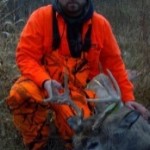LISTEN TO THE PODCAST HERE:
He’s a DIY hunter from Wisconsin, and over the last 30-plus years, he’s taken over 75 bucks on public land in Wisconsin

He’s a DIY hunter from Wisconsin, and over the last 30-plus years, he’s taken over 75 bucks on public land in Wisconsin. Steve, welcome to the show Welcome to another episode of Whitetail Rendezvous. This is your host, Bruce Hutcheon, and I’m really pleased to have Steve Butnick with me today. Steve, welcome to the show.
Steve: Thank you. Thanks for having me.
Bruce: So, Steve. Wait a minute: 75 deer, 30-plus years, rifle and bow. How have you been able to do that on public land here in Wisconsin?
Steve: Well, I kind of use other hunters to my advantage, most of the time. Once I learn an area, I will figure out where all the pressure is and try to hunt the … the areas where the deer would feel safe. And try to find the staging areas. Usually thicker cover. Usually thicker cover for me, especially bull hunting.
Bruce: So, are you near the bedding areas, then, or are you in a transition area?
Steve: I like to hunt the transition areas, usually in agricultural areas. If there’s a meadow, near a field or a saddle, a ridge, a valley there, where they seem to kind of hunker down until right before dark. Mornings, I will try to hunt closer to their bedding area. You Get in there before they sneak back.
Bruce: Now, are you taken a climber with you, or do you have pre-set tree stands on public land?
For most of my public land hunting I do use a climber.
Steve: It depends where I hunt. I have … for most of my public land hunting I do use a climber, like a nice summit, nice and quiet and I have the trees pre-scouted so I don’t make a lot of noise getting in. I do hunt some small parcels of public land, and those I have fixed stands, which is nice, you know, because you know where you’ve got to be.
Bruce: Now, in Wisconsin you can leave your stands up on public land, or how’s that work?
Steve: No, you can if you have your name on it and it’s all done legally, like no screw-in steps, like a ladder stand. You’ve got to have your name and address on it.
Bruce: Kind of like a duck line then.
Steve: Yeah, or an ice shanty. They got to know, the DNR needs to know whose it is and that.
Bruce: Well that’s good. Now, let’s talk about how this hunting all began for you. The hunting tradition, that’s how I like to call it. So, who got you started hunting?
The hunting tradition
Steve: That would be my dad. When I was young, it used to drive me nuts when he’d go deer hunting. I’d have to stay home, because I wasn’t old enough. He used to go up to Northwoods, to deer camp, and then, finally, I always walked along with him, partridge hunting and stuff, so I knew I wanted to hunt and was always excited to see him bring a deer home. So, and then my dad, he started me up bow hunting right when I was legal–at 12 years of age in Wisconsin–and obviously gun hunting, but it took me,I think I was four years before I shot my first deer. A young doe and boy, that was still one of my best.
Bruce: Was that on public land, then?
Steve: That was, yes.
Bruce: Now, do you ever hunt private land, somebody’s farm or other cover?
Steve: Yes, here and there, when I’m lucky enough to get access to some private land. It is nice, because I’m used to hunting the pressured land and when I can hunt something that isn’t so pressured, it’s a lot nicer for me.
Bruce: Let’s talk about the pressure land, because we both know a tremendous amount of bow hunting takes place, both in archery and then we have that nine-day season where a half a million people are going to be out in the woods. So, let’s talk about how you’re able to get in the right place and intercept that buck that’s coming down that trail.
